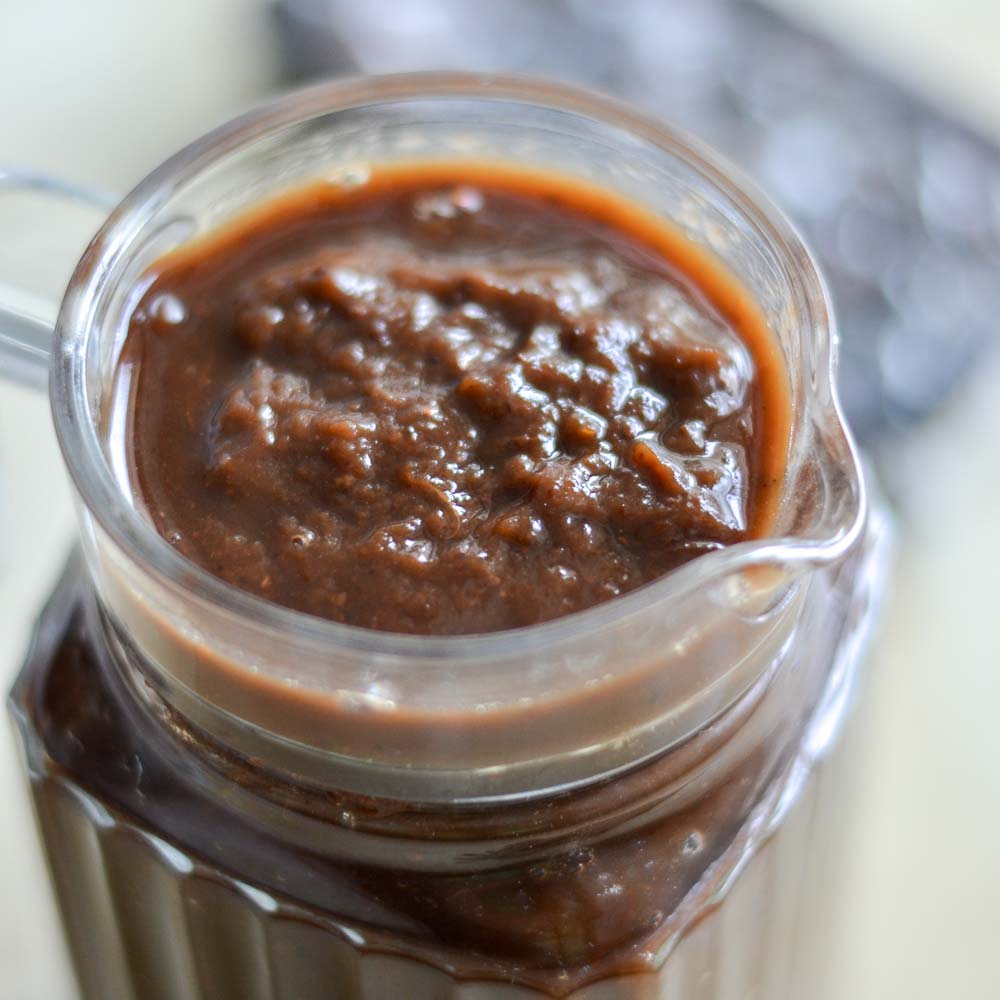
Tamarind paste is a very common ingredient in South Indian Cooking. Its one of the main souring agents that is used in a lot of recipes. Making Homemade tamarind paste is very easy and has a very long shelf life. Its worth the effort and can come in handy in everyday cooking. Here is how to do it. Tamarind Block bought from shops usually comes along with the seed. We need to remove the seeds and the hard fibre before making the pulp. I like to remove the seeds before cooking as it makes for storage after cooking easier.

Take the tamarind and break the tamarind block into bits. Try removing the seeds and the thick fiber. Set aside. Discard the seeds and fibre.
NOTE: Try to buy already cleaned tamarind that has very few fiber and seeds.

Take a pressure cooker and add in the cleaned tamarind and water. Cook for 15 minutes in low flame. After 15 minutes, remove from heat and wait for the pressure to release naturally.

Wait for the tamarind mixture to cool slightly. Blend to a puree and bottle it and use it as required. The blending will work only if the tamarind mixture is free of seeds and fibre.
NOTE: If you think there are lots of bits and pieces of fibre or seeds after cooking, strain the tamarind puree in a colander with wide holes. Do not grind to a paste. Instead, strain in a colander.

A Note on bottling.
# Do not store the tamarind in metal containers as it might react. Its advisable to store the tamarind pulp in a glass or a ceramic jar, the one that does not react.
The Tamarind pulp can be stored in the refrigerator for months.
How to use
The tamarind pulp can be substituted in recipes that call for tamarind to be soaked and made into a pulp. Add a teaspoon for every inch or marble size of tamarind asked for in the recipe.


tamarind paste recipe, how to make tamarind paste at home
Recipe for making home made tamarind pulp from scratch. Making Homemade tamarind paste is very easy to make and has a very long shelf life.
- Total Time: 25 mins
- Yield: 2 cups 1x
Ingredients
- 250 grams Tamarind, cleaned
- 500 ml water
Instructions
- Take the tamarind and break the tamarind block into bits. Try removing the seeds and the thick fiber as much as possible. Set aside. Discard the seeds and fibre.
- Take a pressure cooker and add in the cleaned tamarind and water. Cook for 15 minutes in low flame. After 15 minutes, remove from heat and wait for the pressure to release naturally.
- Wait for the tamarind mixture to cool slightly. Blend to a puree and bottle it and use it as required.
Notes
This recipe has been adapted from the OPOS cooking manual written by Ramakrishnan.
The term OPOS and One Pot One Shot are registered trademarks owned by Mr.Ramakrishnan. The recipes have been adapted using his OPOS principle. They are used in Kannamma Cooks with prior permission.
- Prep Time: 10 mins
- Cook Time: 15 mins
- Category: Basics
- Cuisine: Tamilnadu

It seems to be very informative and we are in this trade as well
Can you make imli ki goli using this imli puree ❓
never tried but I think you can.
I tried this today and have stored it in a glass container in top rack of my refrigerator. Does it last more than 6 months in the refrigerator? Thanks for the recipe.
Hi ,
This is a great tip..I tried it today and it is a great time saver especially when we cook early morning ..My doubt is should we referigerate it? I’m using plastic container for storage doesn’t it affect quality i.e taste wise
yes you have to store it in the refrigerator. I prefer storing it in a glass / ceramic vessel.
You are Just Awesome Suguna, Am 55 Years ol so wonder what to call you, Akka or Tangachi 🙂
Thank you so much. You can call me Suguna. (definetely no akka haha….)
Hi , why does the water separated after a while, is there anything I can mix with it so that it stays mixed .
If the recipe is made correctly with exact measurements, there wont be water left. It will just be a paste.
Hi, what happens to the 500 ml water that we use during the cooking? Should we strain and discard or purée the tamarind along with the water?
Hi Suganya, you have to puree the tamarind along with water.
Love ur received kannama ka
Thank you so much!
Can I store it in a plastic container?
I prefer glass as its non reactive.
Thank you. I will try it
You look beautiful. …and give us easy made receipes .
Such a great timesaver! And tastes SO much better than store bought paste! Thanks for the detailed instructions – I am never going back!
Thank you Bhavana.
hi you are rocking. i just saw your pages. I will try each recipe you posted here. Thanks. Please keep sharing more. 🙂
Hi kannamma,
while cooking can we dilute tis pulp with little water? Its just like soaking tamarind in water n extracting pulp….but we do in large amt n can store ryt? R is there any diffrnc between soaking n extracting and with tis pureed form?….also can we store tis in plastic storage containers?
Yes. you can dilute this with water just before using and add it to curries, kuzhambu etc….
And I prefer to store in in glass jars only.